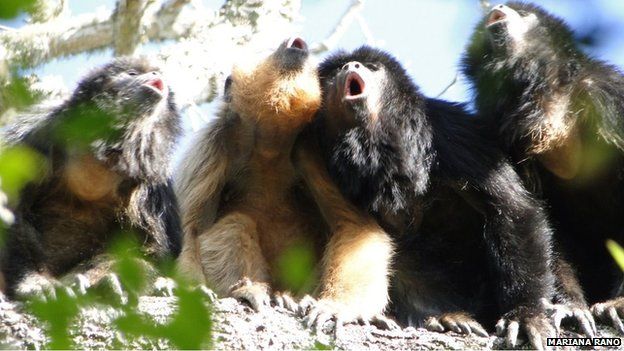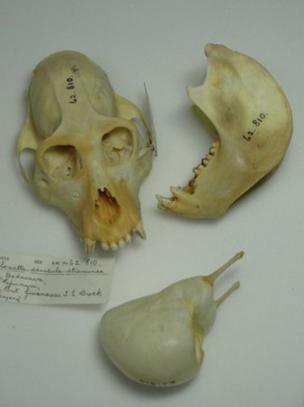watch video
The deep, growling roar of the howler monkey may hide reproductive shortcomings, according to biologists.
A study by an international team of scientists has revealed that the primates either develop big voices, or big testes - but not both.
Scientists made the discovery while trying to understand the "evolution of the animals' incredible roars".
The findings suggest such evolutionary trade-offs may be more common that previously thought.
They are published in the journal Current Biology.
 Mariana Rano
Mariana Rano
Howler monkeys are named for their impressive howling roars - sounds they make to intimidate rivals and impress potential mates.
And their anatomical musical instrument is a bone in their throat called the hyoid bone, which acts as a resonator
So, while their vocal folds act like the strings of an instrument, the hyoid bone is the body - and its size relates directly to the depth of their howl.
 Jacob Dunn
Jacob Dunn
"Females find a deeper howl more attractive," explained lead researcher Dr Jake Dunn from the University of Cambridge.
Looking at research into the different howler monkey species, the researchers found that there was "huge variation" in the size of the hyoid bone.
"The largest hyoid is 14 times the size of the smallest," explained Dr Dunn.
"We became really interested in understanding how and why such amazing variation exists in this trait."
With colleagues from the University of Utah, the team carried out laser scans to calculate the volumes of more than 200 howler monkey hyoid bones from museums in the US and Europe. And to confirm the scans were accurate, the team made MRI images of two adult male monkeys.
As well as measuring the variation, they found that it was connected to another striking physical difference between the species.
"There's also a dramatic difference in the size of the monkeys' testes", said Dr Dunn. "The largest are 6.5 times bigger than the smallest."
Howling for a harem
Comparing the animals, Dr Dunn and his team found that different species of howler monkeys seemed to face a trade-off between "investing in either a huge vocal tract - for making lower frequency, more impressive calls - or large testes - for producing lots of sperm".
Dr Dunn added: "Different species invest in either one or other of these traits, depending on their mating system."
In species where one male has a harem of females and has to compete with other males for the chance to mate, males have deeper voices and smaller testes.
Those with many males in a group - and therefore less vocal competition - had smaller voices, but correspondingly larger testes.
There are some animals - walruses, seals and sea lions, for example - where those with larger bodies have smaller genitals, Dr Dunn explained.
There was even a study published in 2012 suggesting that deeper-voiced men had lower sperm counts.
But this is the first clear example, Dr Dunn says, of a trade-off "vocal investment and sperm production" in any species.
"It was a surprise to find that such trade-offs might be more common than previously thought."
 Stay Updated And Connected With sofogist.Com Daily..
Stay Updated And Connected With sofogist.Com Daily.. 





